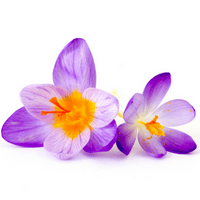 Saffron is harvested by hand from the Crocus sativusflower, commonly known as the "saffron crocus". The term "saffron" applies to the flower's thread-like structures or stigma. Because it is hard to harvest - it takes 75,000 flowers to get half a kilogram of saffron. Saffron is largely cultivated and harvested by hand. Due to the amount of labour involved in harvesting, saffron is one of the world's most expensive spices. The stigmas, and sometimes the petals, are used as a spice, to make herbal supplements, and in manufacturing as a natural dye.
Saffron is harvested by hand from the Crocus sativusflower, commonly known as the "saffron crocus". The term "saffron" applies to the flower's thread-like structures or stigma. Because it is hard to harvest - it takes 75,000 flowers to get half a kilogram of saffron. Saffron is largely cultivated and harvested by hand. Due to the amount of labour involved in harvesting, saffron is one of the world's most expensive spices. The stigmas, and sometimes the petals, are used as a spice, to make herbal supplements, and in manufacturing as a natural dye.
Saffron is thought to have originated in Greece, where it was revered for its medicinal properties. People would eat saffron to enhance libido, boost mood, and improve memory. These days, saffron is a hallmark of Mediterranean cooking. In terms of commercial production, Iran produces about 90% of the world’s saffron and generates most of the research into its potential medical uses.
Saffron extract is composed of at least four main active ingredients which include crocin, crocetin, picrocrocin, and safranal. Crocin is a carotenoid responsible for saffron’s red color. Picrocrocin is converted to saffranal in the body and is an aromatic component that contributes to its bitter taste. Saffranal is responsible for the characteristic aroma of saffron.
Saffron extracts have been extensively studied for their benefits for both mood (depression, anxiety) and neurodegenerative diseases (Alzheimer's, Parkinsons).
The way saffron extracts work is still not fully understood; however, it appears multiple mechanisms are involved. One of the ways saffron works is similar to pharmaceutical antidepressants - that is, it modulates the levels of certain chemicals in the brain, including serotonin (a mood-elevating neurotransmitter).
Saffron supplements are often used to help with low mood (depression). Saffron is also used by those looking for a natural solution to slow the progression of Alzheimer's disease. Other uses include assisting with premenstrual syndrome and painful periods.
Jackson, P.A., Effects of Saffron Extract Supplementation on Mood, Well-Being, and Response to a Psychosocial Stressor in Healthy Adults: A Randomized, Double-Blind, Parallel Group, Clinical Trial. Front. Nutr., 01 February 2021.
Monchaux De Oliveira, C. et al., Saffron Extract-Induced Improvement of Depressive-Like Behavior in Mice Is Associated with Modulation of Monoaminergic Neurotransmission. Nutrients2021, 13, 904.
Hausenblas, H. A., Saffron (Crocus sativus L.) and major depressive disorder: a meta-analysis of randomized clinical trials. J Integr Med. 2013 November ; 11(6): 377–383

In our pursuit of vibrant health, many of us strive for a balanced diet packed with nutrient-rich foods. However, even the most wholesome diet may still leave us lacking in essential nutrients, particularly Omega-3 fatty acids. Healthy Eating is O...

L-Theanine Background & Benefits L-Theanine was originally found in green tea and it is also present in some mushrooms. It was discovered by the researcher Yajiro Sakato in 1949 at the Ministry of Agriculture and Forestry in Kyoto, Japan.Theanine accounts for approximately 50% of the total am...

Ashwagandha Background & Benefits Ashwagandha is Sanskrit for "smell of the horse". This name refers to two characteristics of the herb; one is that the fresh roots emit the smell of a horse. The second reason is that there is a commonly held belief that a person consuming extracts of ashwaga...
Shipping calculated at checkout